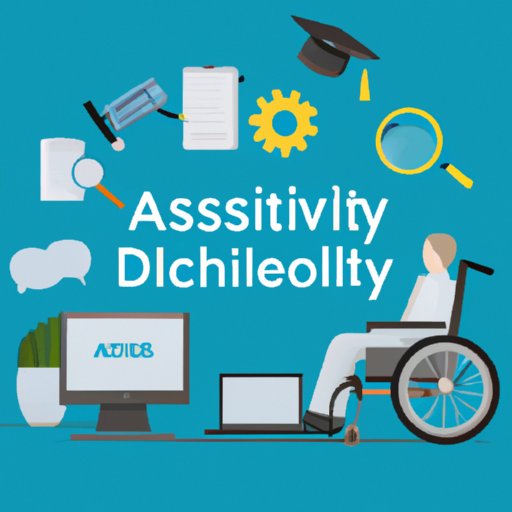Introduction
Assistive technology (AT) is any device or software program that helps people with disabilities improve their ability to perform tasks or activities of daily living. Assistive technology professionals help people with disabilities gain access to the tools they need to live independently and participate in society. Becoming an AT professional requires knowledge of the different types of AT available and the role of the professional in helping individuals access them. In this article, we will explore the qualifications and experience needed, research roles and responsibilities, learning about resources and products, networking, developing a portfolio, and seeking out educational opportunities.
Qualifications and Experience
The qualifications and experience needed to become an AT professional vary depending on the type of position you are looking for. Generally speaking, AT professionals must have a degree in a related field, such as occupational therapy, physical therapy, psychology, special education, communication disorders, computer science, engineering, or rehabilitation counseling, as well as specialized training in AT. Depending on the type of position, additional certifications, such as a Certified Rehabilitation Counselor (CRC) or Assistive Technology Professional (ATP), may be required.
In addition to formal qualifications, it is important to have experience with AT. This can include hands-on experience with AT devices, working with individuals who have disabilities, and/or providing technical assistance and training. AT professionals should also have strong communication, problem-solving, and organizational skills.
Research Roles and Responsibilities
AT professionals typically work in a variety of settings, including schools, hospitals, and community organizations. The specific roles and responsibilities of an AT professional will depend on the setting and the individual’s job duties, but generally include assessing the needs of individuals with disabilities, recommending appropriate AT solutions, providing training and technical assistance, and monitoring progress.
It is important for AT professionals to understand the different roles available and the responsibilities associated with each role. For example, in a school setting, an AT professional might be responsible for conducting assessments, selecting appropriate AT solutions, providing training and technical assistance, and monitoring student progress. In a hospital setting, an AT professional might be responsible for evaluating the needs of patients, recommending AT solutions, and providing training and technical assistance.

Learn About Assistive Technology Resources and Products
AT professionals must stay up to date on the latest AT products and resources available. They should research and learn about various AT products and resources, such as hardware, software, mobile apps, and web-based services. They should also be familiar with different funding sources, such as grants and insurance coverage, as well as local and national AT programs.
It is also important for AT professionals to stay informed about current trends in AT and the needs of individuals with disabilities. This includes attending conferences and workshops, reading articles and journals, and participating in online forums and discussion groups.
Network With Other Assistive Technology Professionals
Networking is an important part of being an AT professional. Networking with other AT professionals can provide valuable resources and information, as well as potential job opportunities. It is also a great way to stay informed about current trends in AT and the needs of individuals with disabilities.
There are several ways to network with other AT professionals. Online networks, such as LinkedIn, are a great way to connect with other professionals. Attending conferences and workshops is another great way to meet and exchange ideas with other AT professionals. Joining professional organizations, such as the Assistive Technology Industry Association (ATIA), is also a great way to network and stay informed about current trends in AT.
Develop a Portfolio
Having a portfolio is an essential part of being an AT professional. A portfolio is a collection of documents, photos, videos, and other materials that demonstrate your knowledge, skills, and abilities in AT. It should include examples of projects you have completed, as well as certificates and awards you have received. Your portfolio should also include a list of references and contact information for former employers and colleagues.
Your portfolio should demonstrate your knowledge and skills in AT, as well as your ability to effectively communicate and collaborate with clients, colleagues, and stakeholders. It should also reflect your commitment to continuing education and staying up to date on current trends in AT.
Seek Out Educational Opportunities
Continuing education is an important part of being an AT professional. There are many different sources for educational opportunities, such as online courses, conferences, and workshops. It is important to take advantage of these opportunities to stay up to date on current trends in AT and to develop new skills and knowledge.
AT professionals should also consider pursuing additional certifications, such as a Certified Rehabilitation Counselor (CRC) or Assistive Technology Professional (ATP). These certifications demonstrate proficiency in AT and can lead to increased job opportunities.
Conclusion
Becoming an AT professional requires an understanding of the different types of AT available, the role of the professional in helping individuals access them, and the qualifications and experience needed. It is also important to stay up to date on current trends in AT, network with other professionals, develop a portfolio, and seek out educational opportunities. By following these steps, you can become an AT professional and help individuals with disabilities gain access to the tools they need to live independently and participate in society.
(Note: Is this article not meeting your expectations? Do you have knowledge or insights to share? Unlock new opportunities and expand your reach by joining our authors team. Click Registration to join us and share your expertise with our readers.)
